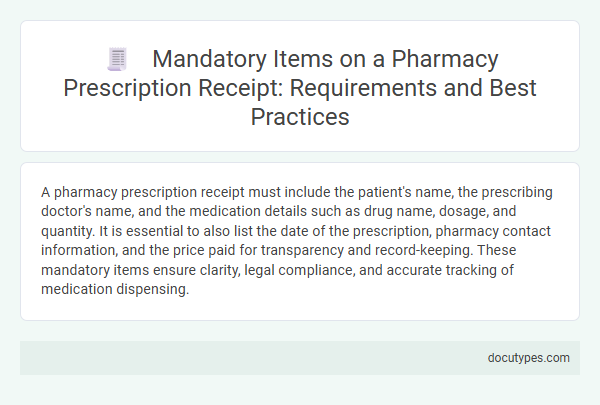A pharmacy prescription receipt must include the patient's name, the prescribing doctor's name, and the medication details such as drug name, dosage, and quantity. It is essential to also list the date of the prescription, pharmacy contact information, and the price paid for transparency and record-keeping. These mandatory items ensure clarity, legal compliance, and accurate tracking of medication dispensing.
Introduction to Pharmacy Prescription Receipt Standards
A pharmacy prescription receipt serves as a vital document confirming the purchase of prescribed medications. It ensures transparency and accountability between the pharmacy and the patient.
Mandatory items on a pharmacy prescription receipt follow specific standards to comply with legal and healthcare regulations. These standards guarantee clear communication of transaction details and patient safety information.
Essential Patient Information Requirements
A pharmacy prescription receipt must contain specific essential patient information to ensure proper medication dispensing and legal compliance. These details help you verify the accuracy of the prescription and maintain clear records for health management.
- Patient's Full Name - Identifies the individual receiving the medication to avoid mix-ups.
- Date of Birth - Confirms patient identity and is critical for age-specific dosage verification.
- Contact Information - Provides a means to reach the patient for consultation or follow-up if necessary.
Prescriber Details: Mandatory Inclusions
| Prescriber Details | Mandatory Inclusions |
|---|---|
| Full Name | The prescriber's full name must be clearly stated to identify the healthcare professional authorizing the medication. |
| License Number | The official license or registration number ensures the prescription is valid and traceable to an accredited prescriber. |
| Contact Information | Includes phone number or practice address, allowing verification or consultation if necessary. |
| Prescribing Facility | The name and address of the hospital, clinic, or pharmacy where the prescription was issued must be included for clarity and record-keeping. |
| Date of Prescription | The exact date the prescription was written is mandatory to confirm the validity period. |
| Signature or Authentication | An authorized signature or digital authentication of the prescriber is required to validate the prescription document. |
| Your Role | You should verify that all prescriber details on your pharmacy prescription receipt are complete and accurate to avoid delays or errors in medication dispensing. |
Medication Description and Dosage Details
A pharmacy prescription receipt must clearly include the medication description to ensure accurate identification of the prescribed drug. This includes the drug name, form, and strength to prevent any confusion during dispensing.
Dosage details on the receipt are essential for patient safety and proper medication adherence. This section specifies the amount, frequency, and duration of the medication to guide correct usage.
Quantity, Refills, and Dispensing Information
A pharmacy prescription receipt must include the quantity of medication dispensed to ensure accurate tracking and usage. It should clearly state the number of refills authorized by the prescribing doctor to avoid confusion and ensure proper medication management. Dispensing information, such as the date of dispensing and the pharmacist's details, is essential for your records and potential future reference.
Pricing and Payment Transparency on Receipts
A pharmacy prescription receipt must clearly display the medication name, dosage, quantity, and price to ensure pricing transparency. Payment method and total amount paid are essential for confirming the transaction.
Itemized pricing, including the cost of each drug and any applicable taxes or discounts, helps customers understand the charges. The receipt should also show insurance contributions and out-of-pocket expenses separately. Transparent payment details protect consumers and facilitate accurate record-keeping.
Legal and Regulatory Compliance Elements
What items are mandatory on a pharmacy prescription receipt for legal and regulatory compliance? A pharmacy prescription receipt must include the patient's name, the prescribing doctor's details, and the medication dispensed. Your receipt should also display the date of purchase, dosage instructions, and the pharmacy's license number to meet legal requirements.
Security Features and Fraud Prevention
A pharmacy prescription receipt must include specific items to ensure security and prevent fraud. These features help verify the authenticity of the prescription and protect your personal information.
- Pharmacy Identification - The receipt should display the pharmacy's name, address, and license number for verification purposes.
- Prescription Details - It must list the medication name, dosage, quantity, and prescribing doctor's information to confirm accuracy.
- Security Features - Elements like watermarks, barcodes, or holograms are included to prevent counterfeiting and alterations.
These mandatory items work together to maintain the integrity of your prescription and safeguard against fraudulent activities.
Best Practices for Record Keeping and Privacy
A pharmacy prescription receipt must include the patient's name, medication details, dosage instructions, prescription number, and the dispensing date. Maintaining accurate and complete records ensures compliance with legal requirements and supports safe medication management. Protecting your privacy involves securely storing receipts and limiting access to authorized personnel only.
What Items Are Mandatory on a Pharmacy Prescription Receipt? Infographic

